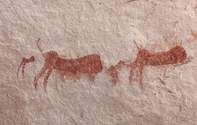
Pre-humans living in East Africa 4.4 million years ago inhabited savannas - grassy plains dotted with trees and shrubs - according to a team of researchers that includes earth science expert Naomi Levin of the Johns Hopkins University's Krieger School of Arts and Sciences.
This conclusion is at odds with a theory - which holds that these early beings lived in a mostly forested environment - put forth by prominent University of California at Berkeley researcher Tim D White and his team in a 2009 issue of the journal Science.
"Our team examined the data published by White and his colleagues last October and found that their data does not support their conclusion that Ardipithecus ramidus lived exclusively in woodlands and forest patches," said Levin, whose team published a commentary on the matter in the May 20 issue of Science.
"The White team's papers stress the wooded nature of A. ramidus's environment and say specifically that Ardi did not live in a savanna. Yet, the actual data they present are consistent with exactly that: a savanna environment with a mix of grasses and trees."
This criticism is important because the claim that the 4.4 million-year-old fossil nicknamed "Ardi" lived in woodlands and forest patches was used as an argument against a longstanding theory of human evolution known as the "savanna hypothesis."
According to that premise, the expansion of savannas - grassy plains dotted with trees and shrubs - prompted our ape-like forebears to descend from trees and begin walking upright to find food more efficiently, or to reach other trees for resources or shelter.
Levin, an assistant professor of earth and planetary sciences at Johns Hopkins, was part of a team of eight geologists and anthropologists from seven universities led by Thure E Cerling of the University of Utah. They used the White team's own data to draw very different conclusions about the environment inhabited by Ardi, an omnivorous, ape-like creature that stood about four feet tall and had a brain less than a quarter of the size of a modern day human's.
This data was collected from ancient soils, plant fossils and other remains in the area now known as Aramis, in Ethiopia.
Levin's team found that tropical grasses, in fact, comprised between 40 and 60 percent of the biomass in Ardi's world.
Levin says her team's conclusion is noteworthy because, if scientists are to evaluate the environmental pressures that triggered the evolutionary success of some traits over others, they must clearly understand the environment itself.
"In their papers and summaries, White and his colleagues emphasize that A. ramidus had a mix of traits that suggest it was at ease both walking upright on the ground and moving through the trees on its palms," Levin explains.
"If the habitat of A. ramidus was, in fact, a woodland with forest patches, where grasses were rare, then it's unlikely that the increased presence of grassy environments were the driving force behind the origin of upright walking in early human ancestors.
However, if the habitat of A. ramidus included savannas where grasses were up to 60 percent of the available biomass, then we cannot rule out the possibility that open environments played an important role in human origins and, in particular, in the origins of upright walking.
The scientific community and the public should not accept an exclusively woodland/forested habitat for A. ramidus and the origins of upright walking, because the data do not support it."
The critique concludes that although its authors do not judge the validity of the savanna hypothesis, the connection between human ancestors walking upright and the expansion of grasslands remains a viable idea.

 Kruger National Park embodies not only the spirit of wild Africa, but is a window into the world that gave birth to humanity itself. Kruger ...
Kruger National Park embodies not only the spirit of wild Africa, but is a window into the world that gave birth to humanity itself. Kruger ...